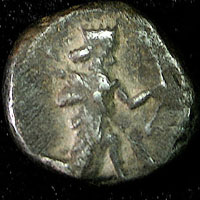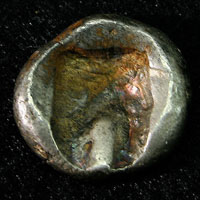Silver Siglos, 485-470 BCE
weight: 5.3g; width: 1.6cm
OBV.: Royal archer running right, quiver on back, holding bow in his left and a transverse spear in his right hand.
REV.: Oblong, tooth-shaped incuse mark.
HFMA nr. 2006.010.009. Ref.: Carradice (1987) siglos type IIIb group A, pl. xii (cf. obverse nr. 17).
This silver siglos (Persian for shekel) was minted during the reign of Xerxes (486-465 BCE). At that point, Persia was a huge empire that was trying to expand further (map). A first attempt by Darius I to invade Greece had failed in 490 BCE with the battle of Marathon. Xerxes, his son, may well have coined this particular coin to hire mercenaries for his own invasion (481-479 BCE). The design, also used on Achaemenid gold coins (darics), shows a running figure with a bow in his right hand. Accordingly, the Greeks referred to these coins as toxotai (archers). The archer is wearing a long, pleated garment, apparently without sleeves so that he has his arms free to shoot. On his head is the crenellated crown (tiara or kitaris) of the Achaemenid kings. In his left hand, he is holding a long lance that is pointing to the ground. The quiver that belongs to the bow is slung over his shoulders. The figure is presented in the so-called Knielauf scheme (1), i.e., running with one knee bent, that can also be found on the HFMA's coin from Thasos or elsewhere in Greek art in representations of Medusa or Nike. The reverse shows a simple, irregular punch mark.
The archer has variously been interpreted as a representation of the Great King himself, of a 'royal hero', or of a god in special avatar (2). The first reading seems the simplest and most likely explanation, not least because of the figure's dress and acouterments. The crown on the figure's head, for example, corresponds exactly to the type of crown most commonly worn by Achaemenid rulers, a "rigid cylinder with crenellated decoration" (3). The luxurious pleats on the archer's garment are also evidence of court dress (4). The bow and lance belong to the items that each king received at his accension to the throne during a ceremony of investiture, together with his crown and royal robe (5). For this reason, the Achaemenid archer coins probably represent the Great King himself adorned with the symbols of his power: crown, royal dress, bow, and lance. These symbols served as reminders that the king had been installed with the blessings of the supreme god, Ahura Mazda, and thus, they promoted the king's divine support and legitimate claim to his throne (6).
O.K.
(1) German Knielauf (pronounced k-NEE-loaf) literally means "knee-running".
(2) See the summary in Alram, Daric.
(3) Calmeyer, Crown. See also the depiction of Darius I hunting on a cylinder seal in the British Museum.
(4) Shapur Shahbazi, Clothing.
(5) Wiesehöfer 2001, 32.
(6) Curtis 2007, 425 makes similar claims for Parthian and Sasanian coins.
Literature:
Alram, M. "Daric", Encyclopedia Iranica.
Calmeyer, P., "Crown", Encyclopedia Iranica.
Carradice, I., "The 'Regal' Coinage of the Persian Empire." In: I. Carradice, ed., Coinage and Administration in the Athenian and Persian Empires. Oxford 1987, 73-108
Curtis, V. S., "Religious Iconography on Ancient Iranian Coins." In: Joe Cribb & Georgina Herrmann, edd., After Alexander: Central Asia before Islam (Proceedings of the British Academy, 133), Oxford: Oxford University Press, 2007, pp. 413-434.
Shapur Shahbazi, A. "Clothing", Encyclopedia Iranica.
Wiesehöfer, J., Ancient Persia. From 550 BC to 650 AD, London 2001.



